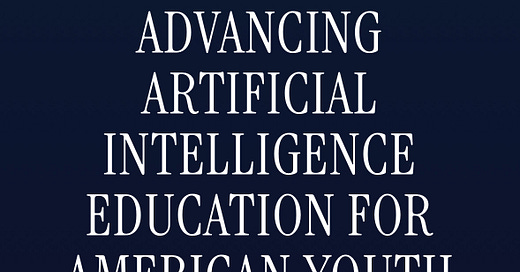Today, the White House released a Presidential Memorandum titled Advancing Artificial Intelligence Education for American Youth. It’s a headline-worthy step toward prioritizing AI literacy in schools. The memo calls for coordinated federal action to provide students with “equitable and safe” access to AI education
As someone deeply invested in teaching AI literacy to students and educators, I wanted to feel excited. But after reading it closely, I’m left with more questions—and concerns—than confidence.
Here’s What the Memo Promises:
AI Literacy for All Students: Foundational concepts introduced early and reinforced throughout K–12.
Equity and Inclusion: A commitment to serving historically underserved communities.
Teacher Support: Professional development is flagged as a key focus.
Safety and Responsibility: Vague references to “responsible use” of AI tools.
Here’s What Worries Me:
Educators Were Not Included. Nowhere does it say this was developed with input from classroom teachers, school librarians, or students themselves. It reads like something drafted by policy advisors and tech consultants—not people in schools.
Private Tech Companies Will Likely Lead. With no details on who creates the curriculum or tools, this opens the door for Big Tech to dominate AI education. That rarely ends well for students—or teachers.
Are We Replacing Teachers with Tools? This could be a slow creep toward automating instruction. If AI tutoring or assessment tools are used to justify cutting staff or reducing teacher-student interaction, we’re in serious trouble. We saw what happened during remote learning—kids need humans, not just algorithms.
A Glaring Omission: Ethics, Law, and the Environment. The memo says nothing about teaching students how to ethically use AI, understand legal implications, or even discuss AI’s environmental impact. That’s not just a missed opportunity—it’s irresponsible. These conversations are essential to AI literacy.
Trust Is Earned—And I’m Not There Yet. I don’t trust this administration—to implement a top-down AI strategy in schools without significant educator input and full transparency.
What Can We Do Now?
Use the Memo as a Conversation Starter. Bring it to your school or district leaders and ask: How are we preparing for this? Are educators helping shape our AI literacy efforts?
Push for Transparency and Teacher Leadership. Insist that any AI tools used in your school be vetted by educators—and that students learn how to question and critique AI, not just use it.
Keep the Focus on Students and Relationships. AI can be a powerful support tool—but it can’t replace what teachers do best: connect, inspire, and adapt in real time.
This memo is a big signal that AI in education is about to scale nationally. But unless we act now, we risk letting others define what that looks like.
Let’s make sure it’s done with us—not just to us.
What do you think? Helpful progress or high-tech overreach? I’d love to hear your thoughts in the comments.
— Elissa




